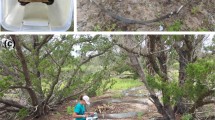Abstract
The critically endangered Mangrove Finch (Camarhynchus heliobates) is a habitat specialist restricted to mangroves, with a global population size of about 100 individuals. Due to its extremely limited geographic range and low dispersal capabilities, translocations of individuals to different mangrove areas within its historic range have been considered. We studied foraging behaviour, food abundance and nest site choice to support decisions for the choice of sites for translocation. Mangrove Finches principally searched for their food in dead wood, litter and the apical buds of red mangrove (Rhizophora mangle), where they mainly fed on spiders, caterpillars and beetles (adults and larvae). The intense use of litter confirmed that separation from a direct flow of seawater in the mangroves was an important component of habitat suitability. Even though red mangrove is an important feeding substrate, Mangrove Finches cannot safely build their nests in the branch structure of this tree species: they always placed nests in the outermost branches of the lower canopy of black (Avicennia germinans) and white (Laguncularia racemosa) mangrove trees and showed a pronounced preference for black mangrove where available. Nests were located in tall trees within patches of high mangroves that were often flooded during high tide. Such mangroves are rare on the Galápagos,which thus may contribute to the natural rareness of the finch.
Zusammenfassung
Die geschätzte Populationsgröße des vom Aussterben bedrohten Mangrovenfinken (Camarhynchus heliobates), ein Habitatspezialist der Mangroven der Galápagosinseln, beträgt nur 100 Individuen. Wegen ihrer limitierten geographischen Verbreitung und der geringen Ausbreitungsfähigkeit wird die Umsiedelung einiger Individuen zu historisch bekannten Mangrovengebieten ins Auge gefasst. Unsere Untersuchung über die Art der Nahrungssuche, die Verfügbarkeit von Nahrung und Nestplatzcharakteristika soll die Entscheidung für ein geeignetes Gebiet unterstützen. Mangrovenfinken suchen ihr Futter vorwiegend in Todholz, Laubstreu und Blattwirteln der roten Mangrove (Rhizophora mangle), und sie fressen hauptsächlich Spinnen, Raupen und Käfer (auch Larven). Die intensive Nutzung der Laubstreu bestätigt, dass eine räumliche Trennung, welche ein direktes Einfließen des Meeres in die Mangroven verhindert, eine wichtige Habitatskomponente ist. Rote Mangroven sind ein wichtiges Nahrungssubstrat, sie sind aber für den Nestbau nicht geeignet. Nester werden ausschließlich in die äußeren Zweige der schwarzen (Avicennia germinans) und weißen (Laguncularia racemosa) Mangroven gebaut; erstere wird bevorzugt. Nester werden bevorzugt in hohen Baumbeständen gebaut, die bei Flut häufig überflutet sind. Solche Mangrovengebiete gibt es jedoch nur spärlich auf den Galápagos, was zur natürlichen Seltenheit des Finkes beitragen mag.




Similar content being viewed by others
References
Brumm H, Farrington H, Petren K, Fessl B (2010) Evolutionary dead end in the Galápagos: divergence of sexual signals in the rarest of Darwin’s finches. PLoS ONE 5:e11191
Curio E, Kramer P (1964) Vom Mangrovenfinken (Cactospiza heliobates Snodgrass und Heller). Z Tierpsychol 21:223–234
Dvorak M, Vargas H, Fessl B, Tebbich B (2004) On the verge of extinction: a survey of the mangrove finch Cactospiza heliobates and its habitat on the Galápagos islands. Oryx 38:1–9
Eibl-Eibesfeldt I (1961) Über den Werkzeuggebrauch des Spechtfinken Camarhynchus pallidus (Slater und Slavin). Z Tierpsychol 18:342–346
Fessl B, Young HG, Young RP, Rodriguez-Matamoros J, Dvorak M, Tebbich S, Fa JE (2010a) How to save the rarest Darwin’s finch from extinction: the mangrove finch on Isabela island. Philos Trans R Soc Lond B 365:1019–1030. doi:https://doi.org/10.1098/rstb.2009.0288
Fessl B, Dvorak M, Vargas FH, Young HG (2010b) Recent conservation efforts and identification of the Critically Endangered mangrove finch Camarhynchus heliobates in Galápagos. Cotinga (in press)
Grant PR (1999) Ecology and evolution of Darwin’s finches, 2nd edn. Princeton University Press, Princeton
Grant PR, Grant BR (1980) The breeding and feeding characteristics of Darwin’s finches on isla Genovesa, Galapagos. Ecol Monogr 50:381–410
Grant PR, Grant BR (1997) The rarest of Darwin’s finches. Conserv Biol 11:119–127
IUCN (1998) Iucn guidelines for re-introductions. IUCN, Gland, Switzerland and Cambridge, UK
Petren K, Grant BR, Grant PR (1999) A phylogeny of Darwin’s finches based on microsatellite DNA length variation. Proc R Soc Lond B 266:321–329
Smith JNM, Grant PR, Grant BR, Abbott IJ, Abbott LK (1978) Seasonal variation in feeding habits of Darwin’s ground finches. Ecology 59:1137–1150
Tebbich S, Taborsky M, Fessl B, Dvorak M (2002) The ecology of tool-use in the woodpecker finch (Cactospiza pallida). Ecol Lett 5:656–664
Tebbich S, Taborsky M, Fessl B, Dvorak M, Winkler H (2004) Feeding behaviour of four arboreal Darwin’s finches: adaptations to spatial and seasonal variability. Condor 106:95–105
Acknowledgments
We thank S. Gaona and several Galápagos National Park guards for their help in fieldwork. We are grateful to the Park for providing logistic support. This research was funded by the UK Government’s Darwin Initiative Fund (Project number 15005) and a student grant by Galápagos Travel. We thank A. Mauchamp and B. Poulin and two anonymous referees for their valuable comments on the manuscript. This publication is contribution number 2025 of the Charles Darwin Foundation for the Galápagos Islands.
Author information
Authors and Affiliations
Corresponding author
Additional information
Communicated by T. Friedl.
Rights and permissions
About this article
Cite this article
Fessl, B., Loaiza, A.D., Tebbich, S. et al. Feeding and nesting requirements of the critically endangered Mangrove Finch Camarhynchus heliobates . J Ornithol 152, 453–460 (2011). https://doi.org/10.1007/s10336-010-0610-0
Received:
Revised:
Accepted:
Published:
Issue Date:
DOI: https://doi.org/10.1007/s10336-010-0610-0




